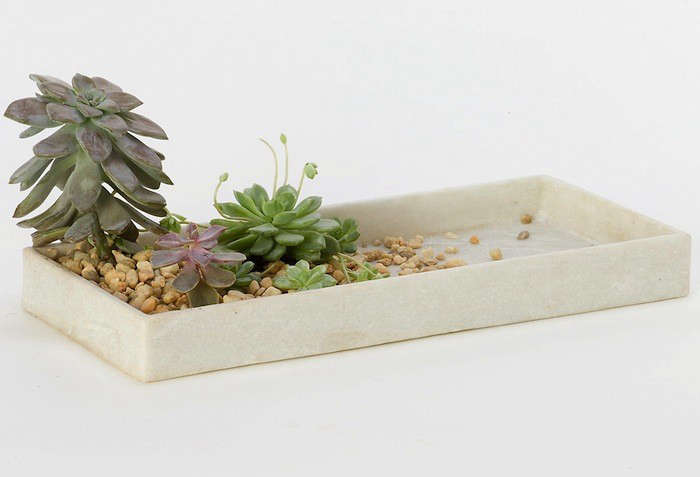Whether your potted plants live indoors year round or have sought temporary shelter from freezing temperatures, they may be looking a little sad these days. Are you doing something wrong? Or have they just gone dormant? We asked horticulturalist David Clark (who is coddling his own houseplants through the winter in upstate New York) for advice about how to perk up winter-frazzled houseplants.
Clark, an instructor at the Buffalo and Erie County Botanical Gardens, likes a challenge: he managed to keep a 4-foot gardenia topiary alive for four years and has collected more than 300 different orchids. But whether you’re nursing something finicky like an African violet or a hardy Mother in Law’s tongue, your houseplants are going to have a harder time in winter. Here are his top 10 tips (plus one of our own) :
Relocate them to a sunny spot.

Put houseplants in the sunniest spot you have; move them to follow the sun if necessary. “Most plants will not thrive in a north-facing window because they need more sun,” says Clark. The best? A window facing east; you will get sun from 7 am to 11 am and “it’s not harsh, like what you’ll get in a western facing window,” he says.
To move big, heavy pots, put them on rolling plant stands. See 5 Favorites: Rolling Plant Stands.
Water them less.

“Most plants only need water once a week in winter,” says Clark. “They will kind of go dormant, especially if they’re plants that grow outdoors in summer and they’ve come from that bright light into a home with lower lighting and lower temperatures.”
A watering can with a long spout will direct a controlled stream of water to a houseplant–without dribbles. For our current favorite, check this month’s Editors’ Cut: 15 Accessories For the Doting Houseplant Parent.
Make sure to mist.

Outdoor plants experience fog, rain, and mist. Indoors? The air is dry from your heating system. Give them a little spritz from a mister every few days to keep houseplants happy.
Here’s our favorite Brass Plant Mister.
Create some humidity.

Make a humidity tray for plants to add moisture to the air. In a low-sided tray, place a shallow layer of pebbles. Add water to the height of the pebbles. Set plant pots on pebbles and put the tray in a warm sunny spot (or on top of a radiator).
Or get a desktop humidifier. Most plants thrive with levels of from 50 to 60 percent humidity; in a house the humidity level can go below 35 percent. “In a situation like that, make them a little miniature greenhouse by tenting them under a big plastic bag,” says Clark. “Or take a shallow tray, fill it with 2 inches of water and gravel, and set your potted plant in it.” As the water evaporates, it will create humidity around the plant.
Treat them to a tonic.

The most common disease that plagues houseplants is leaf spot–yellow or brown spots that develop on an outer leaf and move inward. If your plants are suffering, mix a tonic and spray it on their leaves: Dissolve 4 teaspoons baking soda in a gallon of water and add a few drops of Murphy’s oil to make a suspension.
Give them a dusting.

Keep plants clean. “When they get dusty, that causes plants not to breathe. It plugs their leaves, which have little pores called stomata,” says Clark. “If you cover a leaf surface with dirt, it won’t get the full effect of sunlight and photosynthesis will be slowed.”
Bathe them.

For smaller plants, give them a bath in a sink with a sprayer. Larger plants can go into the shower. Wipe leaves with a damp sponge. Then off their leaves so they don’t drip all over the floor.
Stop fertilizing.

Many plants go dormant in the winter. Don’t fertilize–and don’t give up on them. Come spring, set dormant plants outdoors in warm sunshine and feed them a superfood such as sea kelp. For more, see Gardening 101: Sea Kelp for Healthy Houseplants.
Crank up the heat.

Turn the heat up high during the day, then way down at night. The temperature variance feels familiar to plants because it mimics the conditions they would experience outdoors in the course of a 24-hour period.
Get rid of bugs.

Make your own sticky traps to catch those tiny black bugs–they’re fungus gnats–that buzz in the air above houseplants. For step-by-step instructions, see DIY: Sticky Traps for Fungus Gnats.
Other solutions are to bury a garlic clove in the soil, make an apple cider vinegar trap, or repot plants. For more, see DIY: Pest-Free Potting Soil.
Play music.

Need houseplant help? See:
- 10 Low-Maintenance Houseplants.
- How to Keep a Potted Citrus Tree Happy in Winter.
- Goodbye, Gnats: Pest-Free Potting Soil.
- Gardening 101: Sea Kelp for Healthy Houseplants.
Finally, get more ideas on how to plant, grow, and care for various houseplants with our Houseplants: A Field Guide.
N.B.: This post was first published February 2015 and has been updated with new links and products.















Have a Question or Comment About This Post?
Join the conversation (8)